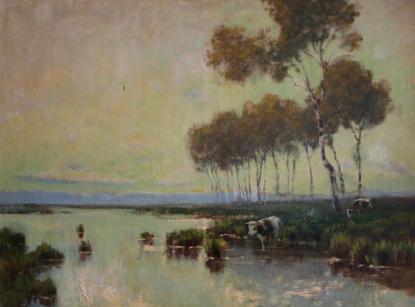2025. April 19. Saturday
Hamza Collection and Jász Gallery - Jászberény
 |
Address: 5100, Jászberény Gyöngyösi út 7.
Phone number: (57) 503-260, (57) 503-261
E-mail: hamzamuzeum@gmail.com
Opening hours: 01.04.-31.10.:Tue-Sat 10-18
01.11.31.03.: Tue-Sat 10-16 |
The exhibition has closed for visitors.
2007.02.22. - 2007.03.18.
Museum tickets, service costs:
|
Ticket for adults
|
400 HUF
|
|
|
Group ticket for adults
(min. 10 people)
|
200 HUF
|
|
|
Ticket for students
|
200 HUF
|
|
|
Ticket for pensioners
|
200 HUF
|
|
|
Guide
|
500 HUF
|
|
|
Photography
|
500 HUF
|
The painter Olgyay Ferenc was born in Jászberény in 1872. He studied in Budapest and Munich after which he settled in Szolnok and was one of the founders of the colony of artists. He painted his landscapes with realistic approach in Szolnok.

From 1893 to 1995 he was among the artists working on the Feszty cyclorama. He won national gold medal in 1905. He held a collective exhibition in the National Salon in 1905 and one in the Könyves Kálmán Salon in 1909.
His early pictures betray his deep studying of nature. Several of his landscapes show the influence of French impressionists.
In 1907, he participated in the establishment of the MIÉNK. In 1911, he traveled to Kecskemét due to the invitation of Grünwald Béla where he managed the colony of artists besides being able to paint. He left the colony in 1914. In 1919, he organized a school for painters in Sárvár. He moved to Budapest in 1920. he died in Budapest in 1939.
The National Gallery holds several of his works.

From 1893 to 1995 he was among the artists working on the Feszty cyclorama. He won national gold medal in 1905. He held a collective exhibition in the National Salon in 1905 and one in the Könyves Kálmán Salon in 1909.
His early pictures betray his deep studying of nature. Several of his landscapes show the influence of French impressionists.
In 1907, he participated in the establishment of the MIÉNK. In 1911, he traveled to Kecskemét due to the invitation of Grünwald Béla where he managed the colony of artists besides being able to paint. He left the colony in 1914. In 1919, he organized a school for painters in Sárvár. He moved to Budapest in 1920. he died in Budapest in 1939.
The National Gallery holds several of his works.
